

www.farmboyzimsflightsims.com
FBZFS
Click On Any Picture For A Larger View
Thanks For The Visit !
One of the most easily recognizable fighter aircraft of World War II was the Lockheed P-38 Lightening. The P-38 ushered in a new way of thinking on how a fighter aircraft should look. Lockheed departed from the path that other designers had been travelling, and came away with an aircraft that was not only different in looks, but power and armaments were also factors that were “redesigned”. Just Flight and the folks over at Aeroplane Heaven have gathered their own team of developers to bring us simmers a Lightening to tear up the virtual skies!
The US Army Air Corps, as it was called back in 1937, wanted a high altitude fighter/interceptor aircraft. They also wanted this aircraft to meet some pretty hefty requirements. As a matter of fact, this set of requirements for the performance of the desired aircraft were the most lofty to date. They wanted an aircraft that had power, as if this was anything new! However, they wanted airspeed of at least 360 mph and wanted her at 20,000 feet in 6 minutes. For this time period, this was no small matter. Lockheed’s Clarence “Kelly” Johnson (of later “Skunk Works” fame), Hail Hibbard, and a crack development and engineering team wasted no time. Right from the start, a twin-engine configuration was considered, for there were no engines that could provide the necessary power in a single-engine set-up, at that time.
The US Army Air Corps, as it was called back in 1937, wanted a high altitude fighter/interceptor aircraft. They also wanted this aircraft to meet some pretty hefty requirements. As a matter of fact, this set of requirements for the performance of the desired aircraft were the most lofty to date. They wanted an aircraft that had power, as if this was anything new! However, they wanted airspeed of at least 360 mph and wanted her at 20,000 feet in 6 minutes. For this time period, this was no small matter. Lockheed’s Clarence “Kelly” Johnson (of later “Skunk Works” fame), Hail Hibbard, and a crack development and engineering team wasted no time. Right from the start, a twin-engine configuration was considered, for there were no engines that could provide the necessary power in a single-engine set-up, at that time.
The P-38 utilized a tricycle landing gear. Most fighters of the day were “tail-dragger’s”, but the Lightning broke new ground in the fighter category here, as well. I for one, find it a lot easier to see over the nose in the P-38, which makes taking off a bit easier, as well as taxiing! One notable incident with the P-38 upon landing happened a few short weeks after the XP-38 first took to the skies. The Army Air Corps, ever anxious to toot its own horn, had the aircraft flown from California to New York, in which it had set a cross country speed record. The flight took 7 hours and two minutes, but landed short of the runway, and the aircraft was wrecked. The pilot made it out OK however. Even after this mishap, the Air Corps was still fired up over their new plane, and ordered 13 YP-38’s.


"Curly Six" with rocket pods
I want to mention here, that over on the other side of the Atlantic, the Fokker G.1 had already caused quite the stir at the 1936 Paris Air Show. The G.1 was a twin-boomed aircraft as well. Test flights were always under close supervision, but in May of 1941, two Dutch pilots were able to elude a German escort, and take their G.1 to England, where it was studied. It is not known to me whether Lockheed had gotten wind of the G.1 through covert methods before this incident, or if they came up with the design simply out of necessity dictating form.
The design of the P-38 deviated entirely from the standard of the day. It had to be different, in order to perform the way the Air Corps wanted. Twin-booms housed the two sets of engines, turbo superchargers, and at the end of each, the tail assembly. At the time the initial XP-38 was being developed, two engines were needed to achieve the performance specs, though later in the war, further advances in engineering technology enabled single engines to achieve even faster speeds. The props rotated outward, in a counter-rotational configuration, to counter the effects of torque. The power behind the Lightning was two, 1,000 hp turbo-supercharged 12-cylinder Allison engines. These engines provided excellent power, especially in the climb.
The design of the P-38 deviated entirely from the standard of the day. It had to be different, in order to perform the way the Air Corps wanted. Twin-booms housed the two sets of engines, turbo superchargers, and at the end of each, the tail assembly. At the time the initial XP-38 was being developed, two engines were needed to achieve the performance specs, though later in the war, further advances in engineering technology enabled single engines to achieve even faster speeds. The props rotated outward, in a counter-rotational configuration, to counter the effects of torque. The power behind the Lightning was two, 1,000 hp turbo-supercharged 12-cylinder Allison engines. These engines provided excellent power, especially in the climb.

Fokker G.1
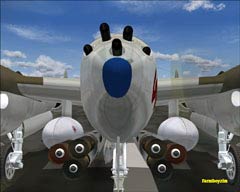
Armament was located in the nose of the center nacelle, and in most versions of the P-38, consisted of four .50 calibers and a 20mm canon. This mass of firepower was usually concentrated into a hit zone of 3 - 5 feet, straight out in front of the guns. Pilots were able to shoot farther and more accurately since there was no criss-crossing effect that was used to aim wing mounted weapons. With such a configuration of guns, the fire power was incredible, often likened to a buzz-saw effect. The center nacelle held not only the guns but was where the pilot called home as well. Bombs and rockets were also part of the ordanance that the Lightning was able to carry, for ground attack roles.

Recon Lightning
This thing packed a punch!
Quick note here on designations…XP-38 would be the experimental aircraft, whereas YP-38 is the test aircraft. The YP’s were redesigned in some areas, to accommodate construction and other factors, since the XP’s were just about entirely hand built. Another notable difference between the XP-38 and the YP-38 is that the earlier “X” model had props that rotated inward whereas the “Y” had props that rotated outward, making the aircraft a more stable gun platform. The British had ordered a batch of P-38’s, a variant of the P-38E, but these were not outfitted with turbo-superchargers, due to an export limitation imposed by the US. They were also not rigged for counter-rotational props, but came with twin right-handed rotating props. This was due to parts commonality issues with other aircraft.
There were problems that the design teams still had to overcome, and the major one was that of the infamous high-speed compressibility stall. This was a problem the Lightning experienced when it entered a steep dive. At speeds around .68 mach while diving, the general consensus was that the tail would flutter, causing the nose to pitch down even further, and the control surface would lock up. Later tests determined it was not entirely a tail-flutter problem. Upon reaching denser air, the pilot had a small chance to pull out of this dive, but later models of the P-38 incorporated dive-flaps to alleviate the problem.
There were problems that the design teams still had to overcome, and the major one was that of the infamous high-speed compressibility stall. This was a problem the Lightning experienced when it entered a steep dive. At speeds around .68 mach while diving, the general consensus was that the tail would flutter, causing the nose to pitch down even further, and the control surface would lock up. Later tests determined it was not entirely a tail-flutter problem. Upon reaching denser air, the pilot had a small chance to pull out of this dive, but later models of the P-38 incorporated dive-flaps to alleviate the problem.
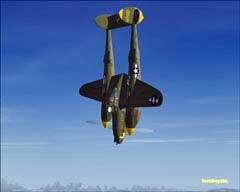
Watch those steep dives!
It may have the advantage of a spare engine, in case something goes wrong with one of them, but pilots of the P-38 had to learn an entirely new way of dealing with an engine-out situation upon take-off. The normal routine would be to apply more power to the remaining good engine, but if this was done in the case of the Lightning, the aircraft would flip over onto itself. Reducing power on the good engine, feathering of the bad, and then a gradual increase in power to the good engine was the way to go. These single-engine take off’s were not possible, however, if the aircraft had a full combat load, the procedure just wouldn’t work, too much weight.
There were no “B” or “C” designated P-38’s as the USAAF decided to jump right to the “D” designation. Throughout the stages of the P-38’s development, improvements were constantly being implemented. Armored cockpits, armor glass, self-sealing tanks were all used to increase the survivability of the pilot and the aircraft.
There were no “B” or “C” designated P-38’s as the USAAF decided to jump right to the “D” designation. Throughout the stages of the P-38’s development, improvements were constantly being implemented. Armored cockpits, armor glass, self-sealing tanks were all used to increase the survivability of the pilot and the aircraft.
The P-38 served in both the Pacific and the European Theaters of War. It was nicknamed the “Fork-Tailed Devil” by the enemy. Most notable of the P-38 pilots was Dick Bong, the United States’ highest scoring ace with 40 victories, all within the P-38. Bong had served in the Pacific, and then was shipped back to the States, where he was killed in an aircraft crash, ironically on the day of the Enola Gay mission. In the Pacific Theater, the P-38 shot down over 1800 enemy aircraft. It was a flight of P-38’s that downed the plane General Yamamoto was in, while on one of his inspection tours. Over 100 pilots achieved the venerable “Ace” status while flying the P-38 in the Pacific.
While in the European Theater, the Lightning flew over 13,000 sorties. The P-38 faired well against a well-trained and experienced enemy, considering the fact that the majority of the missions that were flown, were prior to allied air-superiority. Because of the aircrafts strong points, the Lightning was able to hold its own against a more experienced enemy.
I’ve explored just the tip of the iceberg as far as the facts surrounding the P-38 and its place in aviation history. I certainly encourage you to research the Lightning further, as there is a wealth of information on this beautiful bird!
While in the European Theater, the Lightning flew over 13,000 sorties. The P-38 faired well against a well-trained and experienced enemy, considering the fact that the majority of the missions that were flown, were prior to allied air-superiority. Because of the aircrafts strong points, the Lightning was able to hold its own against a more experienced enemy.
I’ve explored just the tip of the iceberg as far as the facts surrounding the P-38 and its place in aviation history. I certainly encourage you to research the Lightning further, as there is a wealth of information on this beautiful bird!

Richard Bong's P-38 "Marge"
I always like to know a bit about the aircraft that I’m “flying”. I believe that knowing some of the history could have the desirable effect of putting you more in touch with what it is you are experiencing. That’s what simming really is all about, the realism and reliving aviation history, even though it’s on a computer! Aeroplane Heaven has developed a model of the Lightning that really does it justice. So, without further ado, on with the review!

The folks at Just Flight sent me the disc version of the software for review. The product also comes as a download from the Just Flight site. These days, installations are pretty smooth and straightforward, as was the case with this product. Path to FSX or FS9 is one of the few decisions that you have to make. Loading times varied between the two sims, but both were done in a very short time. Before I start in on the actual review, I would like to point out that the majority of the screenshots that I had taken for this review were prior to the Service Pack and Patch coming out from the folks over at Aeroplane Heaven. These fixes addressed the two items that I had found while looking at the model from the spot view. The first was that of the propeller textures not displaying properly and the rockets not appearing to be textured, or painted. Links in the Just Flight Forums lead to fixes and a Service Pack that will remedy these problems. You can see the difference in the images with and without the fixes. SP1 also fixes a problem with the turn and slip gauge direction, as well as an issue when restarting the engines. With these patches in place, everything works as smooth as a baby’s butt!
Here is the link for the SP1… http://www.justflight.com/support.asp If you downloaded the product after 03/04/08, the SP is already installed. Just hop in and everything should be fine.
Here is the link for the SP1… http://www.justflight.com/support.asp If you downloaded the product after 03/04/08, the SP is already installed. Just hop in and everything should be fine.
"Curly Six" prior to the Service Pack Fix


The model is built with an eye toward detail, and is very smooth looking, not blocky. You can plainly see the amount of effort that has gone into this model. Animated flaps and other control surfaces operated smoothly, along with cowl flaps, cockpit hatch, gun hatch, and gear. All displayed very fine detail. The paint jobs were many, representing 17 variations in all, and were very well done for the models that were covered in this product, the P-38J and F models, as well as the “Glacier Girl”, which was rescued from the ice. The story of the “Glacier Girl” is one worth looking into, and is too long for this review, but I encourage you to check it out.
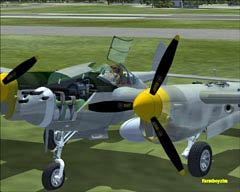



Overall, the paint jobs were excellent, although some of the nose art images had me scratching my head. You’ll note, however, if you have seen more than a few examples of “Nose Art” on real-world aircraft, you probably have seen some that were, to say the least, interesting! Aeroplane Heaven took the time to paint in lines, rivets, stains and other details, both small and significant. It’s my opinion that a model can be the smoothest built around, little or no “polygons” showing, but if it does not have a detailed, or even a passable paint job, it just doesn’t have the same appeal. The smallest to the largest of details seem to have been afforded the same amount of attention, which naturally makes for a great model. What’s the old saying, “Take care of the pennies and the dollars will take care of themselves”!
Some of the more “famous” P-38’s, such as the recon Lightning, a P-38J F5 that was flown by the aviator Antoine de Saint-Exupery, who vanished without a trace while on a mission is depicted. Major Richard Bong’s P-38J, “Marge” is included as well. Bong was the top American Ace of World War II with 40 enemy shot down in the Pacific Theater. “Marge” was Bong’s wife, and her likeness is seen on the nose of his aircraft...and no, it’s not a “racy” picture either! It was his wife, after all! Other notable P-38’s are the “Virginia Marie” (hubba-hubba!!!), “Porky II”, “Journey’s End”, and others.
Some of the more “famous” P-38’s, such as the recon Lightning, a P-38J F5 that was flown by the aviator Antoine de Saint-Exupery, who vanished without a trace while on a mission is depicted. Major Richard Bong’s P-38J, “Marge” is included as well. Bong was the top American Ace of World War II with 40 enemy shot down in the Pacific Theater. “Marge” was Bong’s wife, and her likeness is seen on the nose of his aircraft...and no, it’s not a “racy” picture either! It was his wife, after all! Other notable P-38’s are the “Virginia Marie” (hubba-hubba!!!), “Porky II”, “Journey’s End”, and others.
Excellent detail
Looking in on the pilot

Demonstrating the "Buzz Saw" effect!
Recon version
Opened up and ready for inspection!
Recon version with corrected prop textures after fix
My favorite color green!
The P-38F and the P-38J, which were the most often used of the models for combat, are the aircraft rendered in this product. The recon versions of the Lightning have no weapons, but are loaded with cameras (no snapping pics, they’re just for looks!). The various fighter versions will “fire” when the “I” key (otherwise used for smoke) is pushed. A little hint here…to speed up the “rate of fire”, adjust the “key repeat” in the Keyboard settings of your systems control panel. A faster “key repeat” equals a faster rate of fire. I found this out simply because I know that my key repeat is set at a slow pace, so the weapons were sounding more like the firing rate of a field artillery piece! The effects of the nose blazing away with the four 50’s and the canon, and the ammunition casings tumbling away make for a very cool effect! Other standard animations are in place, such as the canopy cover, port window open and close, and the hatch to the gun bay in the nose of the center nacelle. In the case of the recon version, you can peek at the cameras used for snapping pics of the enemy. Look for the access ladder to appear as well. This drops down to the rear of the center pod.
Human figures have come a long way in being modeled within Flight Simulator. The figures that resided in the pilot seat were sometimes downright scary looking! Nothing personal in the event that some of these were modeled after the developer! The character sitting in the seat of the P-38 is a very determined looking individual, perhaps a bit “punchy” looking, but hey, this guy has seen a lot of action! He is well modeled and animated with smooth head movements. A much more realistic looking human figure than the “polygon people” of yesterday!


All these things, both large and small, make for a great looking model, but even though she looks good, can she dance? Absolutely! This model really stands out in the areas of performance, interior functionality, and sounds. There is no 2D cockpit, which, to be honest, I miss, but the Virtual Cockpit is outstandingly detailed, and just about fully functional, in regards to switches, buttons, and levers. If you go into the 2D cockpit view, you will see either no instruments at all, or, using the “W” key, the basic instruments view at the bottom of the screen. In this view, your standard instruments are there, but I found it odd that there was no compass or direction indicator. While flying from the virtual cockpit, there is an uncanny sense of being in a real aircraft…almost! They have done an outstanding job with the interior, although the night lighting on the panels could be a bit better. Pop up panels are the Radio and GPSbut there are no simicons, so you must use key commands to bring these up.
Gauges function smoothly utilizing a technology called “Liqui-Drive”, which was not really explained, so you got me as to what exactly this is, but it seems to do the job! The panels are very authentic looking, which certainly adds to feel of realism! For the amount of detail, I was truly surprised at how smoothly everything operated, with outstanding frame rates. Once in awhile, when switching views, it might take a second or two for the graphics to catch up, but this is a system issue, not the product. These minute hits on performance are no doubt due to the graphic settings being cranked up fairly high, with the realism maxed, for my settings. Aeroplane Heaven did a great job replicating the effects of the unique flight dynamics of this war bird. With its counter-rotating props and excellent visibility, take-off is easier than in, say, a P-51 Mustang, where if you are not careful, you’ll flip right over before leaving the ground! A minimum amount of rudder needs to be used to keep her on the line down the runway.
Gauges function smoothly utilizing a technology called “Liqui-Drive”, which was not really explained, so you got me as to what exactly this is, but it seems to do the job! The panels are very authentic looking, which certainly adds to feel of realism! For the amount of detail, I was truly surprised at how smoothly everything operated, with outstanding frame rates. Once in awhile, when switching views, it might take a second or two for the graphics to catch up, but this is a system issue, not the product. These minute hits on performance are no doubt due to the graphic settings being cranked up fairly high, with the realism maxed, for my settings. Aeroplane Heaven did a great job replicating the effects of the unique flight dynamics of this war bird. With its counter-rotating props and excellent visibility, take-off is easier than in, say, a P-51 Mustang, where if you are not careful, you’ll flip right over before leaving the ground! A minimum amount of rudder needs to be used to keep her on the line down the runway.
A determined looking pilot!
Lots of exterior detail


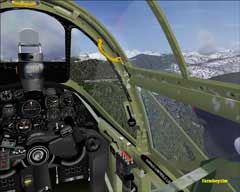





I also experimented with how the model replicated the compression problem that the Lightning experienced in high-speed dives. This was done in the “F” model as the “J” model had dive flaps implemented to prevent loss of control. I was unable to pull out of my dive, which started out at around 20,000 feet. Even though speeds in excess of 600 plus were reached, she held together…until being met by the ground that is! So yes, loss of control is mimicked very well when one goes into a dive in the P-38F. The implementation of those dive flaps made a difference in the later models of the lightning, and I was able to pull up safely. Well done FDE developers!
The sounds in this package are great. It’s been a few years since the Reno Air Races, which was the last time I heard what a real P-38 sounds like, but if I recall, it’s like the high performance whine of a Formula Race car, versus the sounds of my 1965 Chevy pickup truck (which in all reality really sounds good!). Turn off the lights, turn up the volume, and it is easy to imagine yourself in this bird. The sounds for this model rank up there with some of the best that I have heard.
A printed manual comes with the product, and covers the basics of what you will be looking at in the P-38, along with flight information, from start up to shut down. All information is presented in a very easy to understand format. A nice bit of historical info is included as well. Most simmers of all experience levels should be able to get through the manual with no problem. At 25 pages in length, you get quite a bit of information about this remarkable aircraft. It is printed only in English.
The sounds in this package are great. It’s been a few years since the Reno Air Races, which was the last time I heard what a real P-38 sounds like, but if I recall, it’s like the high performance whine of a Formula Race car, versus the sounds of my 1965 Chevy pickup truck (which in all reality really sounds good!). Turn off the lights, turn up the volume, and it is easy to imagine yourself in this bird. The sounds for this model rank up there with some of the best that I have heard.
A printed manual comes with the product, and covers the basics of what you will be looking at in the P-38, along with flight information, from start up to shut down. All information is presented in a very easy to understand format. A nice bit of historical info is included as well. Most simmers of all experience levels should be able to get through the manual with no problem. At 25 pages in length, you get quite a bit of information about this remarkable aircraft. It is printed only in English.

"Going down?"
Here’s the scoop, straight from the Just Flight site, with additional comments from me in ( ).
·Highly detailed and fully functional virtual cockpit. (Very true indeed…an incredible amount of mouse-clickable items).
·This aircraft can be started and flown correctly by the numbers from a cold cockpit start. (Works great and is pretty basic. Make sure to get the patches and fixes).
·The cockpit features unique Liqui-Drive (TM) smooth gauges set in authentic housings. (The looks are genuinely authentic looking and extremely smooth in operation)
·Many unique animations.
·Drop tanks can be jettisoned from the controls in the VC. (Not sure if it was a glitch on my part or what, but assigning key commands for the drop tanks, in order to “watch” from the spot view as they drop away, did not seem to work. Switch in cockpit did release tanks though).
·Highly detailed gun and camera bays. (Very impressive detail).
·Removable gun sight for improved cockpit vision (A very handy option for a better forward view).
·Working guns and cannon. (“I” key command is used to fire).
·All major and minor controls are operated by the mouse and virtually every lever, switch and wheel is reproduced. (True. Loads of detail, which is why I was surprised with the excellent frame rates!).
·Highly detailed artwork
·17 authentic liveries included
·Paint Kit included allowing you to create your own liveries (Photoshop or compatible software required).
System Requirements…
·FS2004 or Flight Simulator X (Service Pack 2/Acceleration Pack - fully compatible in normal DX9 mode)
·2GHz (3GHz for FSX)
·512Mb RAM (1Gb for FSX)
·128Mb 3D graphics card
·Windows XP/Vista
·850Mb hard drive space
·DVD-ROM drive
I run a HP AMD Athlon 2.16 GHz processor, 1 GB of RAM, an nVidia GE 7600 500Mb graphics card, with CH controls. Not the most powerful of systems, but it does a fine job for me!
I’ll be honest here, when I first received the product, I was just a little disappointed, not in performance, but with the somewhat obvious texture problems. With the Service Pack and patches, I am now convinced that what they say is true, and that is the fact that there is a high quality P-38 model out there now for us simmers to enjoy! From the radios behind the pilot to the tread of the tires, an overall great model! The price of the package is £24.99 / €37.95 / $49.99. If you are the casual simmer, fifty bucks is probably a large chunk of change to drop, but for the P-38 fanatic, or for those that are into the war birds of yesteryear, I think you may find this product worth it, and I'm confident that you'll spend many hours ripping through the virtual skies! It's easy to do in this bird!
If you would like more information on this package, visit the folks at Just Flight at www.justflight.com.
Here's a few more screenshots for you...
·Highly detailed and fully functional virtual cockpit. (Very true indeed…an incredible amount of mouse-clickable items).
·This aircraft can be started and flown correctly by the numbers from a cold cockpit start. (Works great and is pretty basic. Make sure to get the patches and fixes).
·The cockpit features unique Liqui-Drive (TM) smooth gauges set in authentic housings. (The looks are genuinely authentic looking and extremely smooth in operation)
·Many unique animations.
·Drop tanks can be jettisoned from the controls in the VC. (Not sure if it was a glitch on my part or what, but assigning key commands for the drop tanks, in order to “watch” from the spot view as they drop away, did not seem to work. Switch in cockpit did release tanks though).
·Highly detailed gun and camera bays. (Very impressive detail).
·Removable gun sight for improved cockpit vision (A very handy option for a better forward view).
·Working guns and cannon. (“I” key command is used to fire).
·All major and minor controls are operated by the mouse and virtually every lever, switch and wheel is reproduced. (True. Loads of detail, which is why I was surprised with the excellent frame rates!).
·Highly detailed artwork
·17 authentic liveries included
·Paint Kit included allowing you to create your own liveries (Photoshop or compatible software required).
System Requirements…
·FS2004 or Flight Simulator X (Service Pack 2/Acceleration Pack - fully compatible in normal DX9 mode)
·2GHz (3GHz for FSX)
·512Mb RAM (1Gb for FSX)
·128Mb 3D graphics card
·Windows XP/Vista
·850Mb hard drive space
·DVD-ROM drive
I run a HP AMD Athlon 2.16 GHz processor, 1 GB of RAM, an nVidia GE 7600 500Mb graphics card, with CH controls. Not the most powerful of systems, but it does a fine job for me!
I’ll be honest here, when I first received the product, I was just a little disappointed, not in performance, but with the somewhat obvious texture problems. With the Service Pack and patches, I am now convinced that what they say is true, and that is the fact that there is a high quality P-38 model out there now for us simmers to enjoy! From the radios behind the pilot to the tread of the tires, an overall great model! The price of the package is £24.99 / €37.95 / $49.99. If you are the casual simmer, fifty bucks is probably a large chunk of change to drop, but for the P-38 fanatic, or for those that are into the war birds of yesteryear, I think you may find this product worth it, and I'm confident that you'll spend many hours ripping through the virtual skies! It's easy to do in this bird!
If you would like more information on this package, visit the folks at Just Flight at www.justflight.com.
Here's a few more screenshots for you...

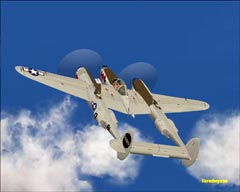



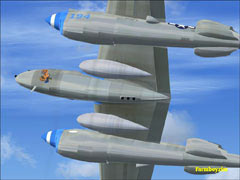


All the way around, detail to be found!
The Lightning in its fast climb
Night textures done well
Even though it's military, it's a great one to site-see in!
Pretty...
...Oh, and shiny too!
Moonlit mission
Panel at night
Aeroplane Heaven's
Lockheed P-38 Lightning
Reviewed by Farmboyzim
Lockheed P-38 Lightning
Reviewed by Farmboyzim
